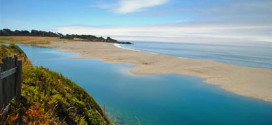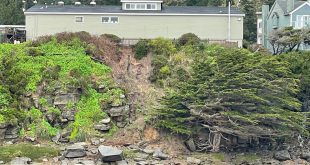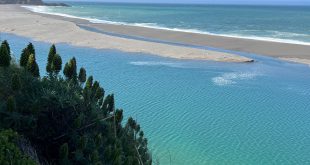by Peter Baye
| This letter was published in the Independent Coast Observer on January 25, 2008. |
Editor:
What’s in a name? Will something called a “soil retention system” rather than a “retaining wall” conserve the natural, mature coastal bluff vegetation along the river bank? In a word, no. Regardless of whether the scenic coastal bluffs along the Gualala River bank are replaced with one type of artificial engineered fill rather than another, they would be buried under either concrete or weeds covering the geotextile web system.
The ICO headline of January 18 gave me the impression that the technical details of materials and design of the proposed retaining wall were more at issue than the construction footprint of the project. That footprint still steps right over the bluff top, and extends developed land over stands of native vegetation, including rare plants, that took many decades to develop.
And for what? Is a retaining wall needed to fix a surface drainage problem? The only parts of the slope that actually need repair are local erosion spots – slides and gullies caused basically by improper surface drainage and past placement of unauthorized, unengineered fills.
What is missing from public discussion of the proposed bluff wall is what is literally and figuratively behind the wall. The bluff retaining wall is like the proverbial tail wagging the dog. The real project is the expansion and reconfiguration of commercial business buildings behind the wall, plans for which have been posted in the window of the old pharmacy building. The wall (and the additional developable square footage or parking it would hold) is only a small part of a larger project.
The term of art for seeking minor, incremental permits for parts of larger projects, without asking for a permit for the whole project, is “piecemealing.”
Most coastal development projects near bluffs in California are generally required to be set back with buffers behind the bluff edge, so that engineering with seawalls and retaining walls are not required. Set-backs and riparian buffer zones along the bluff-top river bank edge may be compatible with public trails. Would they be compatible with additional parking and commercial square footage? Nobody can tell, because the wall project is proposed separately and ahead of the Surf Center development project.
Rather than debate the merits of one kind of wall versus another, it would make a lot more sense to step back and take a second look at the “soil retention system” in the context of the whole Surf Center project plan.
Peter Baye
Annapolis
More information on the proposed “soil retention system.”
 Friends of Gualala River Protecting the Gualala River watershed and the species living within it
Friends of Gualala River Protecting the Gualala River watershed and the species living within it


